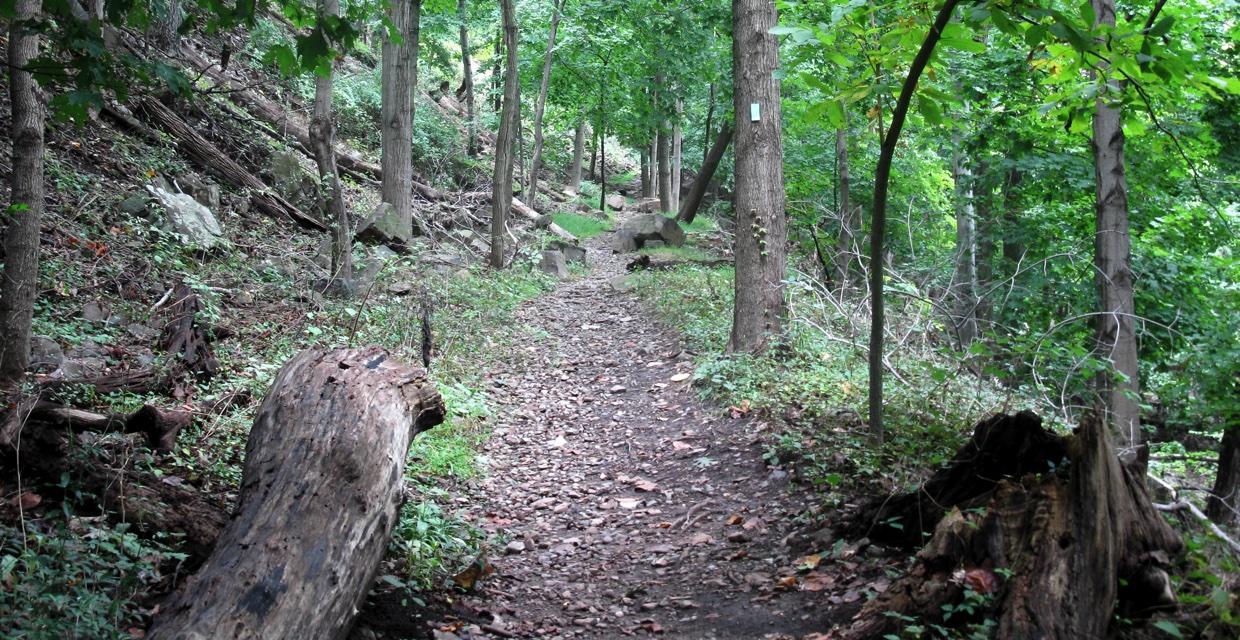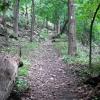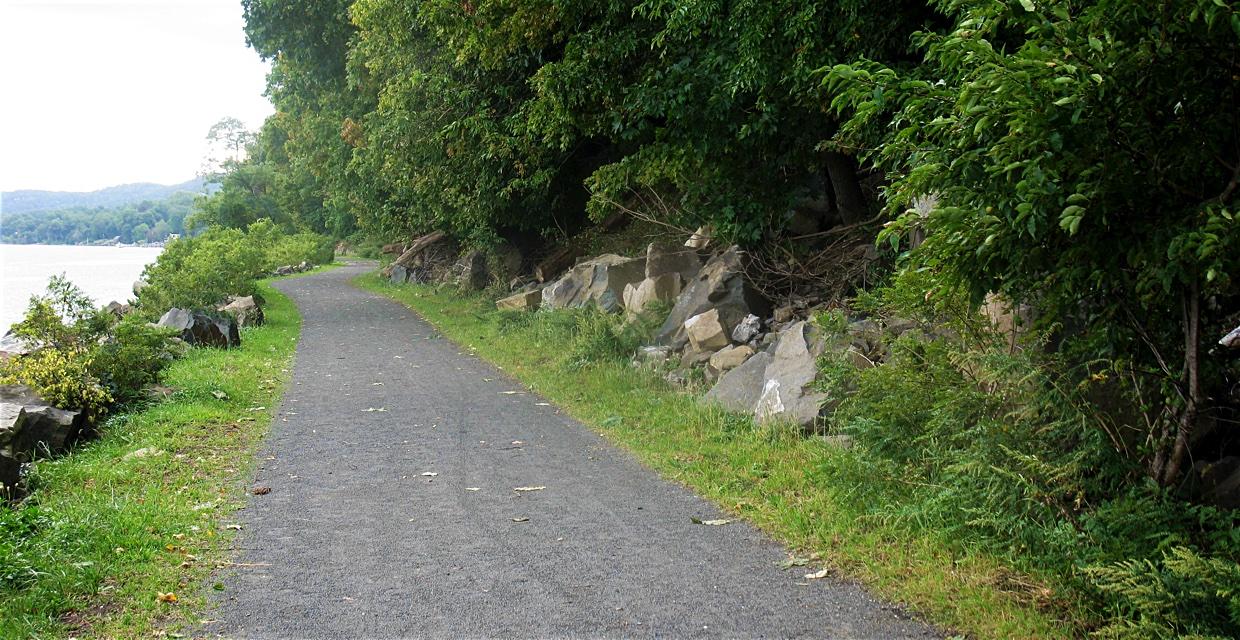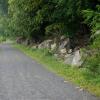Proceed to a kiosk at the northern end of the parking area and continue north for 250 feet on the River Trail. Here, a sign in a grassy area and three white blazes on the left mark the start of the Boulders Loop. This white-blazed trail ascends on a dirt road, passing concrete foundations on the left that afford a view of the Hudson River, and continues uphill on switchbacks. After a level...
Hike Description:
Proceed to a kiosk at the northern end of the parking area and continue north for 250 feet on the River Trail. Here, a sign in a grassy area and three white blazes on the left mark the start of the Boulders Loop. This white-blazed trail ascends on a dirt road, passing concrete foundations on the left that afford a view of the Hudson River, and continues uphill on switchbacks. After a level section, it joins a paved road for 175 feet, then turns right, climbs rock steps and continues along the side of Hook Mountain. This magnificent trail section, which weaves through huge rocks at the base of a talus slope, was constructed by the all-volunteer Long Distance Trails Crew of the New York-New Jersey Trail Conference.
After about a mile, the trail crosses a stream on huge boulders, then begins a steady climb. The last section of the climb is mostly on rock steps. After climbing a long stone staircase, the Boulders Trail reaches a junction with the aqua-blazed Long Path.
Turn right onto the Long Path, which follows an old road. Built in the 1870s, this road was planned to continue to the top of Hook Mountain, but it never was completed. Route 9W, which the old road briefly parallels, may be seen and heard through the trees above on the left. Soon, the old road curves away from Route 9W, and the trail narrows to a footpath, with views of the river through the trees. The trail then bears left and begins to climb rather steeply, then more moderately. As you get a little higher, views open up over Upper Nyack, the Hudson River and the Tappan Zee Bridge.
Just beyond, after curving to the left, the trail turns sharply right (avoid the unmarked path leading straight ahead) and climbs a steep, rocky slope, soon reaching the summit of Hook Mountain, with outstanding views over the Hudson River and the Tappan Zee Bridge. Rockland Lake may be seen to the north (through the trees), with the hills of Harriman State Park beyond. On a clear day, the New York City skyline is visible to the south. You’ll also notice several clumps of prickly pear cactus – the only native American cactus that grows east of the Rocky Mountains. You’ve climbed over 700 feet to reach this point, and you’ll want to take a short break, while enjoying the views.
The trail continues straight ahead, descending from the summit and following the ridge of the mountain, with more views over the river to the east. In another third of a mile, at the base of the descent, a yellow-blazed trail leaves to the left. Continue ahead on the Long Path, which now begins to climb again. Along the way, you'll pass several viewpoints to the right of the trail, with Nyack Beach State Park visible directly below. There is a sheer drop of several hundred feet here, so use extreme caution if you approach the cliff edge!
After reaching the crest of the ridge, the trail continues along the ridge, then turns sharply left and begins a steady descent. Soon, it reaches a switchback in an old road and joins the road as the road curves to the right. This well-graded road is a welcome change of pace from the rather rugged ridgetop trail that you've been following for the last mile or so. The Long Path follows the road as it descends gently along the western side of the ridge, then climbs a little.
After a short level section, the river is again visible through the trees on the right. Just beyond, the road bears left and ascends gently. After passing through a gap in a stone wall, the trail begins to descend. Soon, the trail curves to the left and begins a gentle climb. After reaching the crest of the rise, it descends, passing an interesting wide stone wall on the left.
Just beyond, you'll notice a side trail that leads off to the right, but continue ahead on the Long Path. A short distance ahead, after climbing a little, you'll notice another well-defined side trail on the right. Leave the Long Path and follow this side trail past a series of viewpoints, with Croton Point visible across the river. Directly below, at low tide, you can see the remnants of old docks. These docks were once used to transport ice cut from Rockland Lake to New York City.
After passing several viewpoints, you'll notice another side trail that descends to the left. Follow this trail back to the Long Path and turn right. A short distance beyond, follow the Long Path as it curves sharply to the left and descends more steeply on switchbacks. It continues to descend steeply on an eroded footpath. Near the base of the descent, the trail passes a stone foundation. Here, the trail bears right, skirting old concrete foundations, and reaches paved Landing Road.
Turn right, leaving the Long Path, and follow the paved road downhill. As you near the bottom, you'll see the dramatic cliffs of Hook Mountain on your right. Before the park was created in the early 1900s, this was the site of a quarry. Continue along the road as it passes a stone ranger cabin on the left and becomes a gravel road. A short distance beyond, you'll reach a junction with the River Trail, which joins from the left. Paint markings on a rock at the junction indicate that the distance from here to Nyack Beach State Park is 1½ miles.
Continue ahead as the road, now once again paved, descends to the river level, passing the ruins of a small stone building on the right. At the base of the descent, where the road changes again to gravel, there is a picnic area on the left. The road follows right along the river for the rest of the way back to Nyack Beach State Park, passing overhanging rocks and talus slopes on the right. Along the way, there are continual views across the river, as well as more good views of the cliffs. This beautiful, level path is a pleasant way to conclude your hike, although you may have to share the route with bikers and joggers. The path ends at the Nyack Beach State Park parking area, where the hike began.
Publication: Submitted by Daniel Chazin on 10/10/2002 updated/verified on 06/21/2021



This loop hike climbs to the summit of Hook Mountain on the Long Path, with outstanding views over the Hudson River, and returns via a trail that runs right along the river.
Hike Checklist:
Whether you are going for a day hike or backpacking overnight, it is good practice to carry what we call The Hiking Essentials. These essentials will help you enjoy your outing more and will provide basic safety gear if needed. There may also be more essentials, depending on the season and your needs.
The Essentials
Hiking Shoes or Boots
Water - Two quarts per person is recommended in every season. Keep in mind that fluid loss is heightened in winter as well as summer. Don't put yourself in the position of having to end your hike early because you have run out of water.
Map - Know where you are and where you are going. Many of our hiking areas feature interconnecting network of trails. Use a waterproof/tear-resistant Tyvek Trail Conference map if available or enclose your map in a Ziplock plastic bag. If you have a mobile device, download Avenza’s free PDF Maps app and grab some GPS-enhanced Trail Conference maps (a backup Tyvek or paper version of the map is good to have just in case your batteries die or you don't have service). Check out some map-reading basics here.
Food - Snacks/lunch will keep you going as you burn energy walking or climbing. Nuts, seeds, and chocolate are favorites on the trail.
Sunscreen and insect repellent
Rain Gear and Extra Clothing - Rain happens. So does cold. Be prepared for changing weather. Avoid cotton--it traps water against your skin and is slow to dry. If you are wearing wet cotton and must return to your starting point, you risk getting chills that may lead to a dangerous hypothermia. Choose synthetic shirts, sweaters and/or vests and dress in layers for easy on and off.
Compass - A simple compass is all you need to orient you and your map to magnetic north.
Light - A flashlight or small, lightweight headlamp will be welcome gear if you find yourself still on the trail when darkness falls. Check the batteries before you start out and have extras in your pack.
First Aid Kit - Keep it simple, compact, and weatherproof. Know how to use the basic components.
Firestarter and Matches - In an emergency, you may need to keep yourself or someone else warm until help arrives. A firestarter (this could be as simple as leftover birthday candles that are kept inside a waterproof container) and matches (again, make sure to keep them in a waterproof container) could save a life.
Knife or Multi-tool - You may need to cut a piece of moleskin to put over a blister, repair a piece of broken equipment, or solve some other unexpected problem.
Emergency Numbers - Know the emergency numbers for the area you're going to and realize that in many locations--especially mountainous ones, your phone will not get reception.
Common Sense - Pay attention to your environment, your energy, and the condition of your companions. Has the weather turned rainy? Is daylight fading? Did you drink all your water? Did your companion fail to bring rain gear? Are you getting tired? Keep in mind that until you turn around you are (typically) only half-way to completing your hike--you must still get back to where you started from! (Exceptions are loop hikes.)
Check the weather forecast before you head out. Know the rules and regulations of the area.
The Leave No Trace Seven Principles
Plan Ahead and Prepare
- Know the regulations and special concerns for the area you'll visit.
- Prepare for extreme weather, hazards, and emergencies.
- Schedule your trip to avoid times of high use.
- Visit in small groups when possible. Consider splitting larger groups into smaller groups.
- Repackage food to minimize waste.
- Use a map and compass to eliminate the use of marking paint, rock cairns or flagging.
Travel and Camp on Durable Surfaces
- Durable surfaces include established trails and campsites, rock, gravel, dry grasses or snow.
- Protect riparian areas by camping at least 200 feet from lakes and streams.
- Good campsites are found, not made. Altering a site is not necessary.
- In popular areas:
- Concentrate use on existing trails and campsites.
- Walk single file in the middle of the trail, even when wet or muddy.
- Keep campsites small. Focus activity in areas where vegetation is absent.
- In pristine areas:
- Disperse use to prevent the creation of campsites and trails.
- Avoid places where impacts are just beginning.
- Pack it in, pack it out. Inspect your campsite and rest areas for trash or spilled foods. Pack out all trash, leftover food and litter.
- Deposit solid human waste in catholes dug 6 to 8 inches deep, at least 200 feet from water, camp and trails. Cover and disguise the cathole when finished.
- Pack out toilet paper and hygiene products.
- To wash yourself or your dishes, carry water 200 feet away from streams or lakes and use small amounts of biodegradable soap. Scatter strained dishwater.
- Preserve the past: examine, but do not touch cultural or historic structures and artifacts.
- Leave rocks, plants and other natural objects as you find them.
- Avoid introducing or transporting non-native species.
- Do not build structures, furniture, or dig trenches.
- Campfires can cause lasting impacts to the backcountry. Use a lightweight stove for cooking and enjoy a candle lantern for light.
- Where fires are permitted, use established fire rings, fire pans, or mound fires.
- Keep fires small. Only use sticks from the ground that can be broken by hand.
- Burn all wood and coals to ash, put out campfires completely, then scatter cool ashes.
- Observe wildlife from a distance. Do not follow or approach them.
- Never feed animals. Feeding wildlife damages their health, alters natural behaviors, and exposes them to predators and other dangers.
- Protect wildlife and your food by storing rations and trash securely.
- Control pets at all times, or leave them at home.
- Avoid wildlife during sensitive times: mating, nesting, raising young, or winter.
Be Considerate of Other Visitors
- Respect other visitors and protect the quality of their experience.
- Be courteous. Yield to other users on the trail.
- Step to the downhill side of the trail when encountering pack stock.
- Take breaks and camp away from trails and other visitors.
- Let nature's sounds prevail. Avoid loud voices and noises.
The Trail Conference is a 2015 Leave No Trace partner.
(c) Leave No Trace Center for Outdoor Ethics: www.LNT.org.


